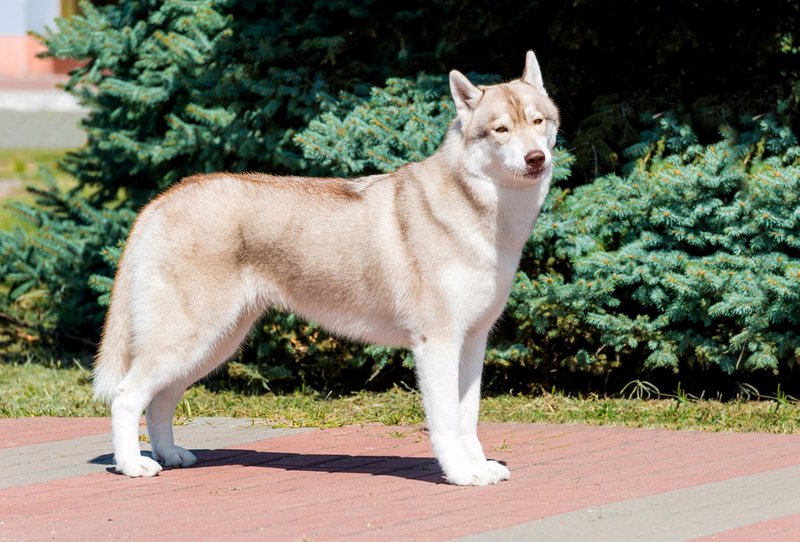When browsing dog breeds, I noticed how common “designer dog breeds” have become. A designer dog is a mixed breed dog with two purebred parents. So it’s no wonder that the Huskita is so popular among dog lovers.
Commonly referred to as the “Siberian Akita,” the Huskita possesses the best characteristics of both parents, the Akita and the Siberian Husky. Huskitas are affectionate and social dogs despite their menacing large body size. With proper socialization, they can become great companions to humans of their loyalty and protectiveness.
The best way to keep your Huskita happy is to keep them busy with tasks and exercise since they usually take after their highly active Husky parent. I’ll cover more on how to keep your Huskita happy, including grooming, training tips, training, and specifics about this relatively new breed. But before I do, let’s discuss its size.
How Big Do Akita Husky Mixes Get?
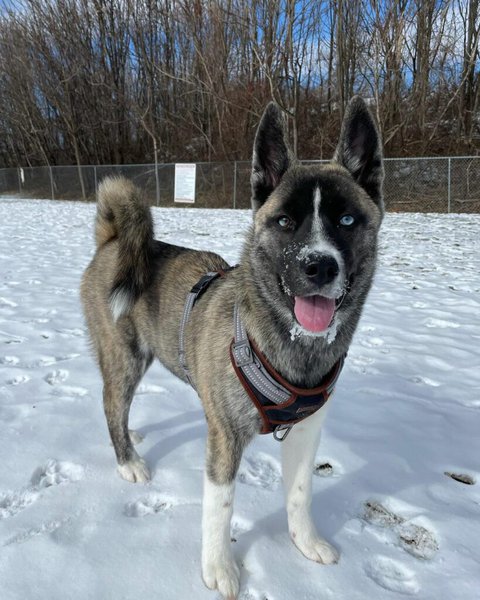
Though size varies, Huskitas are typically medium-to-large-sized dogs. Their average height is between 22 to 25 inches. Their weight is usually between 50 to 75 lbs, depending on muscle mass and bulkiness.
Male Huskitas tend to be larger than females. Since Huskies are medium-to-large-sized dogs while Akitas are large dogs, Huskitas typically fall in between.
Physical Appearance
Huskitas have a captivating appearance with their muscled bodies, wide chest, thick neck, and blocky heads. They have a confident stance and powerful frame that contribute to their overall noble appearance. Their front limbs are straight, while their hind limbs have substantial muscle.
They have well-padded paws, helping them walk long distances and over ice and snow. They have beautiful fluffy tails that rise over their back.
Coat Characteristics
The Huskita breed is excellently protected with a double-layer coat. The undercoat is dense with finer hair. The upper coat has thick, long hair. They inherited the coat from the Husky, who needed protection in freezing climates. The double-layer also protects by reflecting the heat in hot climates.
Take extra care of your Huskita breed until the double coat is completely developed. Before they fully grow their coat, Huskitas can’t withstand cold and need some extra care and protection.
Coat Colors And Patterns
The shades of a Huskita’s coat can be black, cream, gray, sable, tan, and/or white. Its coats may typically be one solid color or have multiple colors with two or three colors. Black and white are the most common colors you can find on a Huskita.
Ears And Eyes
Their ears stand erect in symmetrical triangles, making them good listeners. They handle search operations in police departments because they can catch noises from great distances. The typical shade of their eyes is brown or blue.
How Long Do Akita Husky Mixes Live?
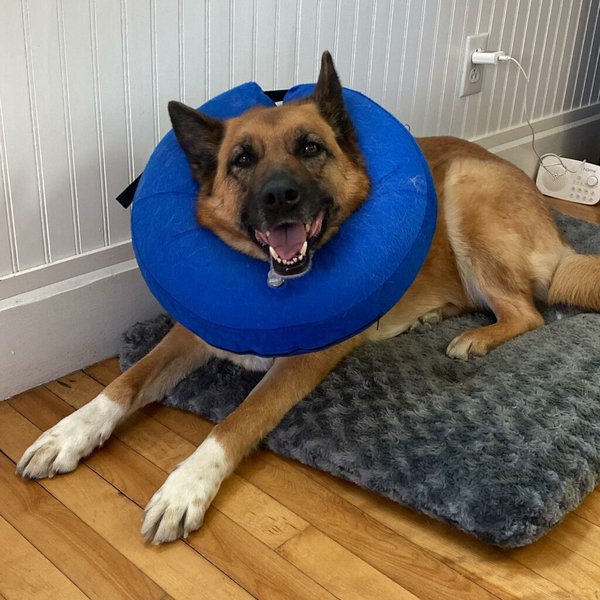
The lifespan of an Akita Husky Mix is said to be between 10 to 13 years. If the Huskita has dominant genes tracing back to that of the Siberian Husky, its lifespan can be extended up to 15 years.
Siberian Huskies are generally healthy and don’t have major health issues. By sharing a lineage from Huskies, this will hold true for Huskitas.
Any disease is treatable once it is detected in its early stages. Hence, visiting the vet regularly for checkups is a must in order to keep your Huskita healthy.
Some of the most common health issues happening to Huskita can include:
Hip Dysplasia
A dog’s hip consists of a ball and a socket. The growth of the ball and the socket may not always grow at the same rate, in which any growth abnormality leads to the rubbing of the ball and the socket, causing tremendous pain. This is hip dysplasia, a condition commonly occurring among medium to Huskitas or large-sized dogs weighing heavier than 50 lbs.
Congenital Laryngeal Paralysis
When the larynx fails to close off the trachea and lungs, dogs would typically face respiratory distress, especially while eating and drinking. In turn, this creates a choking sensation and breathing difficulties due to the paralysis of the muscles within the larynx.
Congenital laryngeal paralysis is how vets will describe this abnormality, and it is often seen in Siberian Huskies. Thus, Huskitas are no exception to this condition.
A common symptom when this paralysis happens is the change in the Huskita’s voice. You should bring your pup down to the vet for a checkup if you notice this change.
How To Take Care Of Your Huskita?
Taking care of your Huskita should be the prime responsibility of all pet parents. Here are the essential aspects to take note of.
Regular Exercise
The Huskita is an active dog breed with so much energy that it needs constant release and regular exercise. This specific trait is likely coming from the Siberian Husky’s parent side, in which Huskies are often bred as working sled dogs.
Hence, it is recommended that you set up an exercise routine for your Huskita, and each exercise session should last 45 minutes per day. Be it a walk or a fun session at the dog park, and your Huskita will surely not say “no.”
Keeping your Huskita busy with games and tasks is another way to do it such that they stay entertained and stimulated. Outdoor activities are key to keeping them happy and manageable.
High-Quality Diet
The typical Huskita diet should be devoid of any carbohydrate-rich supplements as the overconsumption of such supplements can lead to rapid weight gain and health complications due to obesity.
Instead, the diet should contain high protein content and be rich in nutrients such as multivitamins and essential fatty acids. For example, vitamin C and omega-3 oils help boost immunity and cognitive functions, respectively.
Pet Plate has designed a special vet-approved menu that keeps food safety measures in mind and works for different breeds. Each meal is high in proteins and rich in nutrients your Huskita requires daily. Acceptable products for Huskitas include:
- Barkin’ Bee
- Chompin’ Chicken
- Tail Waggin’ Turkey
- Lip Lickin’ Lamp
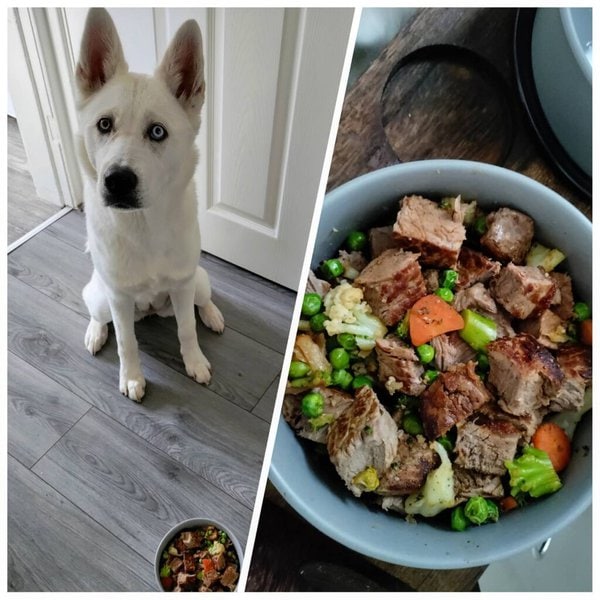
Dental Water Additives
Dental care is often one of the neglected aspects of caring for dogs. Your Huskita will live a lot happier in its maturing years without worrying about gum troubles. You can start this today with the help of dental water additives.
Dental water works as a mouthwash for dogs. It freshens breath and prevents tartar formation. In addition, dental water provides a neutral medium that inhibits the growth of bacteria.
No doubt, dental water cannot replace regular brushing of teeth. It should only be viewed as an additional preventive measure for general dental health.
Are Huskitas Easy To Train? Temperaments Of Akita Husky Mixes
Huskitas are easy to train due to their intelligence trait deriving from a working dog breed, the Siberian Husky. As such, Huskitas can perform a series of tasks with ease after undergoing some training.
You do not need to dominate or assert leadership while training your Huskita. Instead, forming a strong bond with your breed should be the major goal of your training session. Arm yourself with your Huskita’s favorite dog treats, and be firm and clear when giving out instructions.
Let the positive reinforcement do its work, and you’ll find training your Huskita a straightforward process. Every training session with your Huskita should also be made fun and interactive such that it stimulates the dog’s mind every time.
Training Huskitas for security tasks, such as resource guarding or watchdog duty, is ideal due to their strong independent character trait. However, one will be curious if a Huskita will do well with people. Let’s find out next.
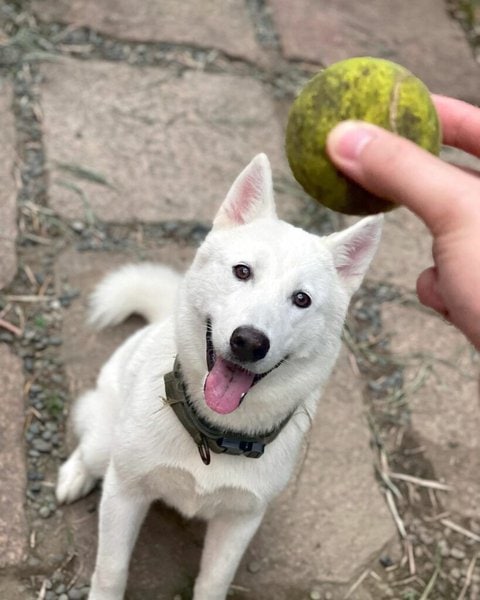
Are Huskitas Good Pets?
The Huskita is an adorable dog who loves to be around people, especially when trained and socialized properly. Huskitas are good pets and can be entertaining and wonderful companions for pet owners.
With adequate socialization, they can even get along with other pets, like cats, very well. What you should do is introduce your Huskita to your cat at a young age.
This helps to bond the both of them and get them to be familiar with each other as they mature. Training a Huskita is not an easy feat and demands a good amount of effort and time from the owner.
Are Huskitas Aggressive?
Huskitas may inherit an aggressive nature from their Akita’s lineage, but this can be addressed with proper training and regular exercise. Suppressing its aggressive trait is very much possible and also requires constant training with consistent training methods.
Therefore, for first-time owners with children, constant supervision of the Huskita when around children is necessary.
A well-trained Huskita is always the preferred choice of crossbreed lovers. You will need to find ways to channel your Huskita’s energy on a daily basis.
Do Akita Husky Mixes Shed? Grooming Tips For Akita Husky Mixes
Yes, Akita Husky Mixes shed a bit, but it is manageable. All you’ll require is a few good brushes per week. Here are some remedies to counter shedding in Akita Husky mixes.
Brush Regularly
Brushing on a regular basis helps remove loose hair off the Huskita’s thick double coat. The popular Furminator Undercoat Deshedding Tool removes loose hair and combats shedding. Its ergonomic design will give you a firm grip for better handling, making brushing effortless.
Owning a Huskita will mean very frequent brushing in the future as it grows bigger. Hence, it is our recommendation that you start brushing your Huskita when young so as to get it used to the brushing. Doing this reduces the hassles of a stubborn pup you may encounter in the future.
Bathe Often
Bathing is important for a Huskita, even though it can go without a proper bath for one to two months. Bathing removes and relieves the skin from dirt and mud; this relaxing effect is what all Huskitas will enjoy after having a fun day outdoors.
To hydrate itchy, sensitive skin, we highly recommend using Pro Pet Works Natural Organic 5 in 1 Oatmeal Dog Shampoo and Conditioner. This product is blended with aloe vera gel and essential almond oils, all of which are renowned for relieving skin itch and healing chapped and irritated skin.
Hypoallergenic
Huskitas are not hypoallergenic. If you are prone to allergies, limit the contact with the Huskita at your home because it may cause serious health issues.
Moreover, frequent vacuuming can help reduce the amount of fur floating or lying around the house that will otherwise trap more dust particles.
Related Questions
How Much Does A Huskita Cost? The estimation of the total cost for a Huskita is from $600 to $2,000, depending on the breeder, bloodline, AKC papers, and verifiable family health history. The Huskita is a popular crossbreed known for its intelligence. The breed is in high demand because of its ability to perform tasks and its loyal companionship. The cost largely depends on which store where you buy the pup from. Though, you will have other options to get this breed from, such as local breeders and rescue shelters.
Do Akitas Get Along With Huskies? Akitas will not get along with Siberian Huskies due to major differences in temperament. Even though they both look somewhat alike, Akitas and Huskies are different dog breeds. Akitas are not considered family dogs because of their antagonistic nature. Huskies, on the other hand, are more social and perfect for a family environment.
Is An Akita Part Of The Husky Family? No, an Akita is not part of the Husky family. Both breeds are fluffy, which may lead you to confuse the Akita with a Husky. However, the Akita is a large breed originating from Japanese mountain regions. They were originally used for hunting purposes. In comparison, Huskies are sled dogs from Siberia. They are both good at taking instructions.

